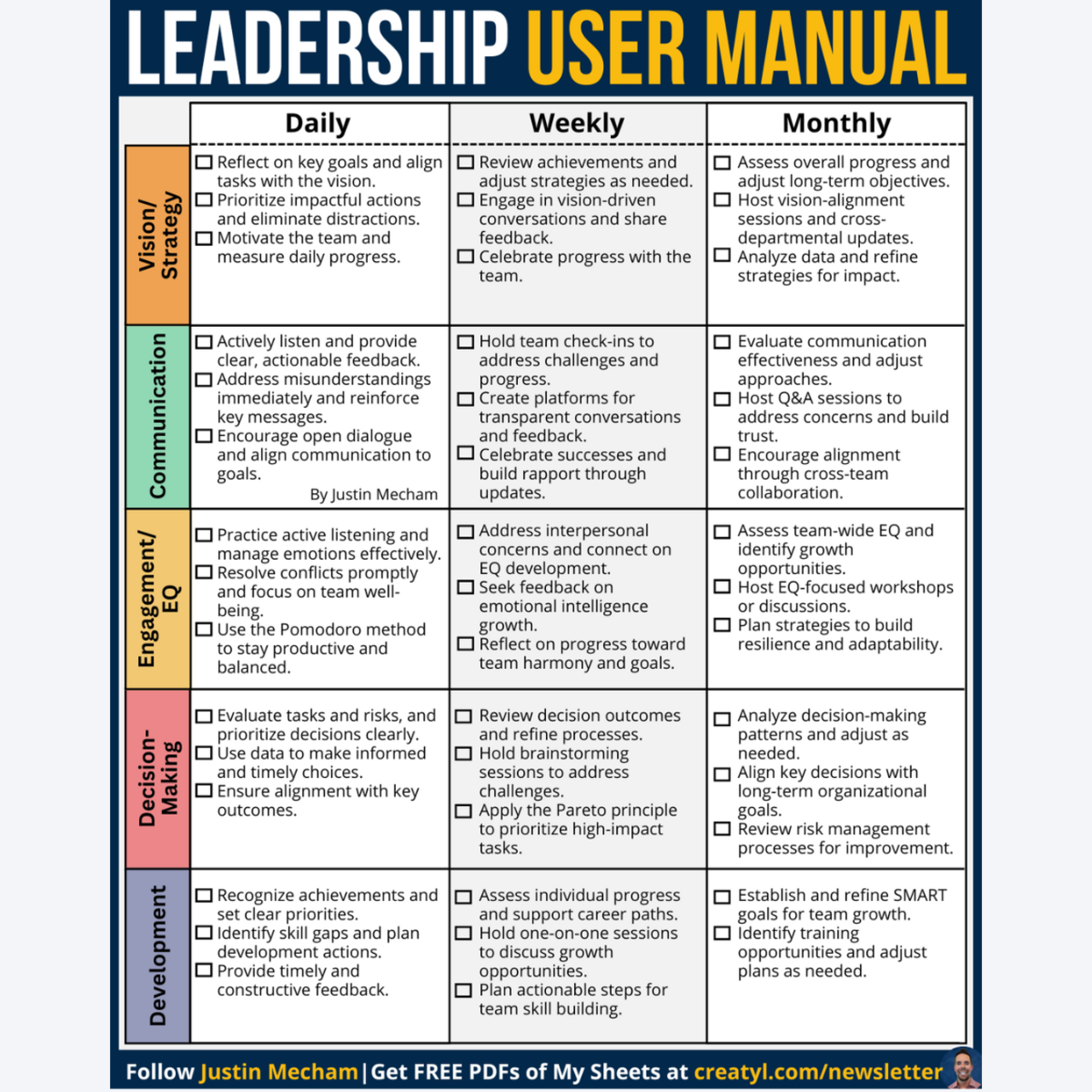Click Here to Download Today's PDF
There’s a truth most leaders don’t talk about enough:
The issue isn’t effort. The issue is rhythm.
Many leaders work hard — late nights, endless meetings, and an inbox that never clears.
But without structure, all that effort scatters.
The team works hard too, but the day is dictated by whoever shouts the loudest, whichever project suddenly turns urgent, or whatever crisis just landed in the group chat.
Great leadership isn’t reactive. It runs on rhythm.
The best leaders don’t just respond — they set a repeatable pace that makes clarity the default, not the exception.
The Problem: When Hard Work Isn’t Enough
A few months ago, I was asked to work with a 40-person product team that had hit a wall.
They were smart, talented, and committed — but they were also missing deadlines, redoing work, and losing confidence in each other’s reliability.
The symptoms were clear:
- Messages flying at all hours
- Priorities shifting mid-day
- Feedback arriving late or inconsistently
- Decisions dragging on for weeks
- Leaders caught up in small fires instead of big outcomes
Everywhere I looked, people were busy.
But the work felt chaotic.
Small problems became big problems simply because there wasn’t a structure to catch them early.
This is where the “Most leaders don’t lack effort — they lack structure” lesson came in.
We needed a rhythm that would keep the important work moving forward without letting daily noise take over.
The Solution: Daily, Weekly, Monthly Rhythms
We used a simple cadence inspired by the Leadership User Manual framework — breaking leadership actions into daily, weekly, and monthly rituals.
It wasn’t about doing more. It was about doing the right things consistently.
Daily → Control the chaos
We started with just five minutes every morning to set the tone:
- If–Then Cards. Each person wrote two likely “tripwires” for the day and exactly how they’d respond. For example: If a client asks for an unplanned change, then I’ll log it in our change review doc and schedule discussion for Friday. This meant fewer knee-jerk yeses and fewer hidden changes derailing progress.
- Noise Windows. Instead of living in Slack or email, we set three specific check-in times. Outside those windows, tabs were closed. This alone cut down on context switching, which research shows is one of the fastest ways to burn mental energy.
- Two-Sentence Feedback. Managers sent quick, clear feedback before confusion could take root: one sentence describing what they saw, and one sentence showing what “good” looked like. That single habit stopped misunderstandings from turning into multi-day fixes.
For leaders looking to lock in these habits, James Clear’s Atomic Habits remains one of the most practical guides for turning intent into repeatable action — and it’s been battle-tested by millions worldwide.
Weekly → Align the humans
Once a week, the team met for just 15 minutes — no long slides, no overstuffed agenda.
The point was to align, not to drown in updates.
We used three key tools:
- The Door Test. Every decision was labeled as either a Two-Way Door (reversible) or a One-Way Door (hard to undo). Two-Way Doors were decided quickly with about 70% of the needed information. One-Way Doors got a short write-up and two outside opinions before moving forward. This kept speed high without risking costly mistakes.
- 7-Minute Premortem. We picked the riskiest piece of work for the week and imagined it had failed. The team listed the three most likely reasons, then identified one preventive step for each. That short exercise exposed blind spots no one had mentioned before.
- Win • Learn • Fix. We ended every week with three bullets: one win to celebrate, one lesson to carry forward, and one process fix to prevent the same issue from happening again.
For leaders who want to inspire clarity and alignment in these short weekly sessions, Simon Sinek’s TED Talk How Great Leaders Inspire Action is still one of the most-watched and most-referenced leadership talks in the world.
Monthly → Lead with altitude
The monthly sessions were a full 60 minutes, and they were about stepping back to see the whole field — patterns, trends, and slow-moving risks that daily work can hide.
The focus:
- Pattern Review. We graded every project stream as Green, Yellow, or Red for both progress and team health. Repeat Yellows were signals to change a rule or process.
- Checklist Factory. If a mistake happened more than twice, it got turned into a 5–9 step checklist. We tested it for two weeks, refined it, and locked it into place. This reduced rework and made quality less dependent on memory.
- Cross-Team “Show-Me” Sessions. Different teams demonstrated how they actually did their work — not the polished version, but the real workflow. These sessions revealed bottlenecks and built relationships that made collaboration faster.
Tools That Help Leadership Run on Rhythm
Structure is easier to keep when the right tools do some of the work for you.
These have proven most useful for leaders I’ve worked with:
- AI Tool: Clockwise — AI-powered calendar assistant that automatically creates focus time and coordinates team schedules. Rated 4.7/5 on G2, used by 40,000+ organizations.
- Tool: Notion — Ideal for storing your one-page Leadership User Manual, decision logs, and Win • Learn • Fix notes in one central, shareable space. Highly rated for flexibility and ease of use.
- Show/Docuseries: The Last Dance — A behind-the-scenes look at the Chicago Bulls’ final championship run, showing how structure, preparation, and clear roles drive performance under pressure.
- Film: Moneyball — A case study in replacing guesswork with a repeatable decision system, even when resources are limited.
The Outcome
Within a month, on-time delivery improved, rework dropped, and internal escalations became rare.
People described their work as calmer, clearer, and more purposeful — even though the workload itself hadn’t changed.
The difference was structure.
Rhythm Is the Real Multiplier
Effort is rarely the missing piece in leadership.
What’s missing is the repeatable rhythm that makes clarity automatic.
Rhythm isn’t about rigid schedules or overplanning.
It’s about creating small, predictable habits that keep the right things moving forward — even on the busiest days.
It’s deciding quickly on reversible choices so you can keep momentum, while slowing down just enough to make your one-way decisions count.
It’s spotting problems early and giving clear feedback before they can spread.
When that rhythm takes hold, the entire team knows what to expect.
They know when feedback will come.
They know how decisions will be made.
They know that work will be measured not just by how much is done, but by whether the right things are moving forward.
The magic is in the consistency.
Over time, that steady beat turns effort into results — and results into trust.
When leadership runs on rhythm, clarity becomes the norm, progress compounds, and the team can finally stop chasing fires and start building something that lasts.
Download the Leadership User Manual PDF
If you’d like a simple, printable version of the Leadership User Manual infographic featured in this article, you can download it as a PDF.
It’s the same framework I use with clients to help them build daily, weekly, and monthly rhythms that make leadership clear, calm, and consistent.




